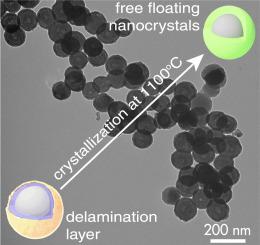Journal of Colloid and Interface Science ( IF 9.4 ) Pub Date : 2020-08-10 , DOI: 10.1016/j.jcis.2020.07.125 Eric Zhang 1 , Yuriy Bandera 2 , Ashley Dickey 2 , Isabell Foulger 3 , Joseph W Kolis 2 , Stephen H Foulger 4

|
X-rays offer low tissue attenuation with high penetration depth when used in medical applications and when coupled with radioluminescent nanoparticles, offer novel theranostic opportunities. In this role, the ideal scintillator requires a high degree of crystallinity for an application relevant radioluminescence, yet a key challenge is the irreversible aggregation of the particles at most crystallization temperatures. In this communication, a high temperature multi-composite reactor (HTMcR) process was successfully developed to recrystallize monodisperse scintillating particulates by employing a core-multishell architecture. The core–shell morphology of the particles consisted of a silica core over-coated with a rare earth (Re = , , Ce3+) oxide shell. This core–shell assembly was then encapsulated within a poly(divinylbenzene) shell which was converted to glassy carbon during the annealing & crystallization of the silica/rare earth oxide core–shell particle. This glassy carbon acted as a delamination layer and prevented the irreversible aggregation of the particles during the high temperature crystallization step. A subsequent low temperature annealing step in an air environment removed the glassy carbon and resulted in radioluminescent nanoparticles. Two monodisperse nanoparticle systems were synthesized using the HTMcR process including cerium doped Y2Si2O7 and Lu2Si2O7 with radioluminescence peaks at 427 and 399 nm, respectively. These particles may be employed as an in vivo light source for a noninvasive X-ray excited optogenetics.
中文翻译:

通过牺牲层方法开发可分散的放射性发光硅酸盐纳米颗粒。
X射线用于医疗应用时以及与放射发光纳米粒子结合使用时,组织衰减低,穿透深度高,可提供新颖的治疗方法。在这种作用下,理想的闪烁体需要与应用有关的放射发光的高度结晶性,然而关键的挑战是在大多数结晶温度下颗粒的不可逆聚集。在这种交流中,成功开发了一种高温多复合反应器(HTMcR)工艺,以采用核-多壳结构重结晶单分散闪烁颗粒。颗粒的核-壳形貌由覆盖有稀土(Re =, ,Ce 3+)氧化物壳。然后,将这种核-壳组装体封装在聚二乙烯基苯壳中,该壳在二氧化硅/稀土氧化物核-壳颗粒的退火和结晶过程中转化为玻璃碳。该玻璃碳充当分层层,并防止了高温结晶步骤中颗粒的不可逆聚集。随后在空气环境中的低温退火步骤除去了玻璃状碳,并产生了放射发光的纳米颗粒。使用HTMcR工艺合成了两个单分散的纳米粒子系统,包括铈掺杂的Y 2 Si 2 O 7和Lu 2 Si 2 O 7分别在427和399 nm处有放射发光峰。这些颗粒可用作非侵入性X射线激发光遗传学的体内光源。











































 京公网安备 11010802027423号
京公网安备 11010802027423号